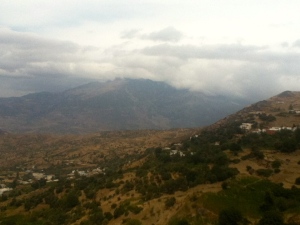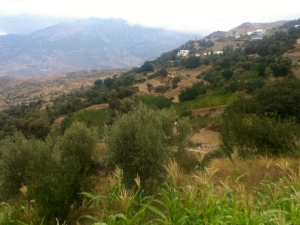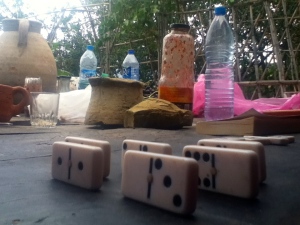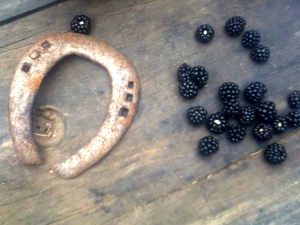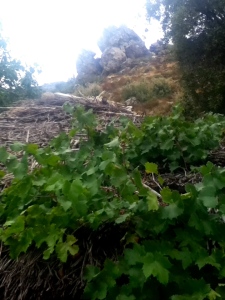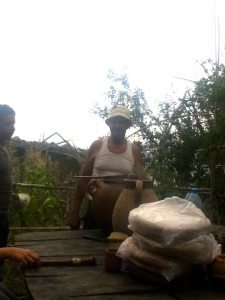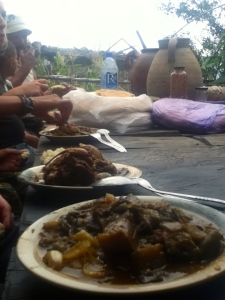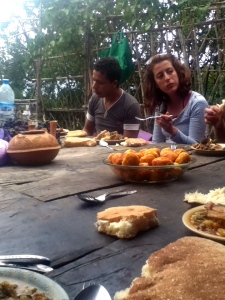As we drove up the mountain towards Akara, we had to make frequent stops so huge dump trucks and backhoes could move aside and let us pass on the narrow dirt road. They were in the midst of creating an official road to connect this village to the more “urban” center of Chefchaouen.
On the way up we saw a young man in a gray sweat suit waving down our car. Thinking we had done something wrong, we slowed down the car to and waited as he ran up to the driver’s window. It turned out he just wanted a ride up to the village. Since we clearly had an extra space in the car, we obliged to take him up. He told us that he was a kif (marijuana) farmer in the mountains and was friends with our host, Ahmed, and offered to show us the way up to his house once we arrived. The “center” of Akara consisted of a few small whitewashed shops, a single café, a bridge over a nearly dried-up river, and a mosque. We were told to park here and we would continue the rest of the way on foot.
Our new hitchhiker friend told us he knew, “the best way” up to his house. Rather than taking the designated trail, we instead cut up through the muddy fields of corn, squash, olive trees, fig trees, and marijuana. With our packs full and our hands busy carrying the extra groceries, we slowly made our way up the steep and muddy slope, all the while hopping over thorn bushes and cacti used to separate one family’s farmland from another. We finally reached a flat plane with a stone farmhouse and were told that we had arrived.
Our host Ahmed is an organic farmer. Rather than growing kif, he prefers to grow produce without using any harmful fertilizers or pesticides. His land boasted several bountiful gardens filled with assorted vegetables. Grapevines were wrapped around every trellis and eave of the house and fig trees created shaded pathways between the house and the various garden areas. Once we dropped our packs, Ahmed encouraged us to go to see the big screen “television” up on the highest point on his property. Confused by what he meant, I followed the group up to realize that Ahmed’s “television” was in reality a breathtaking panoramic view of the mountains beyond and the bowl-shaped green valley below us.
When we returned back to the farmhouse, Ahmed had a large pot of tea waiting for us that was prepared using a special blend of herbs from his garden. We spent the afternoon exploring the property and hanging around the large outdoor table reading, playing cards, and helping ourselves to the large pile of grapes on a silver platter. In the middle of the table there was a swarm of bees that hovered and crawled over glass jars of semet, which is a drink made by crushing the grapes. The semet was leftover from a wedding they attended a few days earlier.
Ahmed was also hosting a WWOOFer named Penny, who was about our age and told us the fascinating story of how she ended up volunteering on Ahmed’s farm in the middle of the Rif Mountains. A little over six months ago she decided to leave everything behind in Mexico and join her friends who were traveling across the world on their bicycles. She met them in Paris, where they then traveled throughout Europe together over several months. Each town or city that they stopped at, the group of friends would perform circus tricks or busk for donations to keep the caravan going. She decided to come to Morocco as a last-minute decision when she realized that her European tourist visa was about to run out and needed to find a place outside of Europe to stay for three months while she waited for it to be renewed. She found Ahmed’s farm as a WWOOFing location where she volunteers her time working on his property in exchange for room and board. In reality, however, she explained to us that her main job at the moment was to make sure that all the fresh figs and grapes were getting consumed on a daily basis.
We had been promised that Ahmed would make us one of his famous tajines. Early on in the afternoon, Ahmed put a wide assortment of vegetables from his garden and the chickens we brought from Chefchaouen into a large clay pot with some local olive oil and spices. The tajine cooked the entire afternoon and by 5 pm it was finally time to eat. We all sat down and ripped off chunks of the bread we bought earlier that day in the market as Ahmed served up piping hot plates of this highly anticipated meal. The table was almost completely silent as we ate at the large table overlooking the valley.
After the tajine, Ahmed took us on a hike further up the mountain to a waterfall. We each took turns walking delicately along the slippery rocks to splash our faces with the cold spring water. As we headed back down the mountain to the farmhouse the sky darkened into purple and pink in the valley below. We walked through the tall fragrant fields of wild grass and marijuana back towards the farmhouse as the sun sank behind the mountains in the distance.
By the time we reached the farmhouse night had fallen. Ahmed set up a propane lamp in the middle of the table and we proceeded to spend the rest of the evening huddled around on the benches playing cards, listening to music, and helping Penny finish the rest of the days’ worth of grapes. Ahmed offered another portion of tajine to each of the omnivores and prepared a “berber omelette”, which was a dish of stewed tomatoes, garlic, herbs, and scrambled eggs that you ate with pieces of bread, for Penny and myself – the vegetarians.
